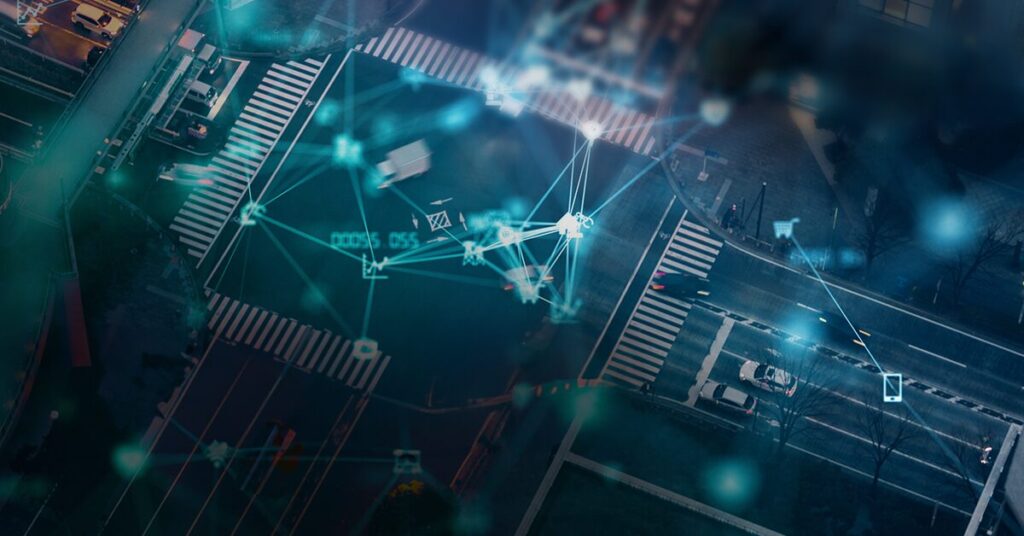The Future Of Transportation

Intelligent Transportation Systems (ITS) are revolutionizing the way we approach mobility. With the rapid rise in urbanization, the demand for smarter, safer, and more efficient transportation networks has become increasingly critical and data is the key to this evolution.
Connected and autonomous vehicles, adaptive signal timing plans, proactive pedestrian awareness, decision support systems, road asset management, and disseminating travel information to commuters, are all essential in ensuring safer and more efficient roads, and their foundation is built upon the integration of data with artificial intelligence (AI).
However, this technological progression highlights the need to architect solutions with a stronger emphasis on cybersecurity and improving the overall cybersecurity posture for critical infrastructure.
In this three-part series, we explore how data can be leveraged to support the Vision Zero initiative, optimize the maintenance and modernization of transportation infrastructure, and eliminate cyber threats before they occur.
Vision Zero
Data is at the heart of the most advanced transportation safety initiatives, like Vision Zero. Vision Zero is a global initiative aimed at eliminating all traffic fatalities and severe injuries while increasing safe, healthy, and equitable mobility for all. Data plays a crucial role in achieving these outcomes by providing insights into traffic patterns, identifying high-risk areas, enabling proactive measures to prevent accidents and more:
- Identifying High-Risk Areas: Traffic data can help pinpoint locations with a high number of incidents, allowing for targeted interventions such as improved signage, better lighting, and redesigned road layouts.
- Real-Time Monitoring and Response: Traffic data provides real-time information on traffic conditions, enabling quicker responses to accidents and hazardous conditions, thereby reducing the likelihood of secondary incidents.
- Predictive Analytics: Using historical traffic data, predictive models can be developed to forecast potential accident hotspots and response times, allowing for proactive measures to be implemented.
- Behavioral Insights: Traffic data can reveal patterns in driver behavior such as speeding, running red lights, hard braking, or frequent lane changes. It can also bright-line peak hours and seasonal variations, all of which can inform educational campaigns and enforcement strategies aimed at promoting safer driving habits.
- Infrastructure Planning: Data on traffic flow and congestion can guide the design and implementation of safer road infrastructure, including pedestrian crossings, bike lanes, and roundabouts.
- Policy Development: Comprehensive traffic data can support the development of policies and regulations that promote road safety, such as speed limits, traffic calming measures, and vehicle safety standards.
- Public Awareness: Sharing anonymized and aggregated traffic insights with the public can raise awareness about road safety issues and encourage community involvement in Vision Zero initiatives.
- Enhanced Technology Integration: Traffic data can be integrated with advanced technologies like connected and autonomous vehicles, adaptive traffic signals, and smart city infrastructure to create a safer and more efficient transportation ecosystem.
Data Sources
OEM data is one of the richest data sources in ITS that can help support Vision Zero. This data is collected from various sensors and systems embedded in modern vehicles and can be used in multiple ways to enhance safety. For example, understanding when and where the airbags are deployed provides meaningful insights for traffic management centers to activate emergency services sooner, leading to reduced risk in secondary incidents and improved responder safety.
Aggregating data from other sources, such as traffic signal controllers, environmental sensors, GPS devices, traffic cameras, and connected vehicles (CV), can significantly impact driver behavior. Information such as weather, road conditions, and what other vehicles ahead are doing, shared through connected vehicle technologies like onboard unit messaging, combined with ITS devices managed by traffic management centers such as dynamic message signs, can prevent incidents by course-correcting drivers’ behavior in real time.
Data Management
However, the key to unlocking the full potential of this data lies in its effective management. This involves the ingestion into a common data platform, like our advanced transportation management platform, iNET®, for aggregation and data science. By doing so, meaningful insights can be extracted from the data, providing valuable information that can be used to make our roads safer and more efficient. Identifying patterns in historical data can also help indicate root causes of incidents and lead to more effective mitigation strategies. When combined, these insights can help save crucial minutes in emergency response time, ultimately maximizing the potential for saving lives.
Safety First
By leveraging traffic data in these ways, cities and communities can make informed decisions that align with the Vision Zero initiative, ultimately creating safer roads for everyone.